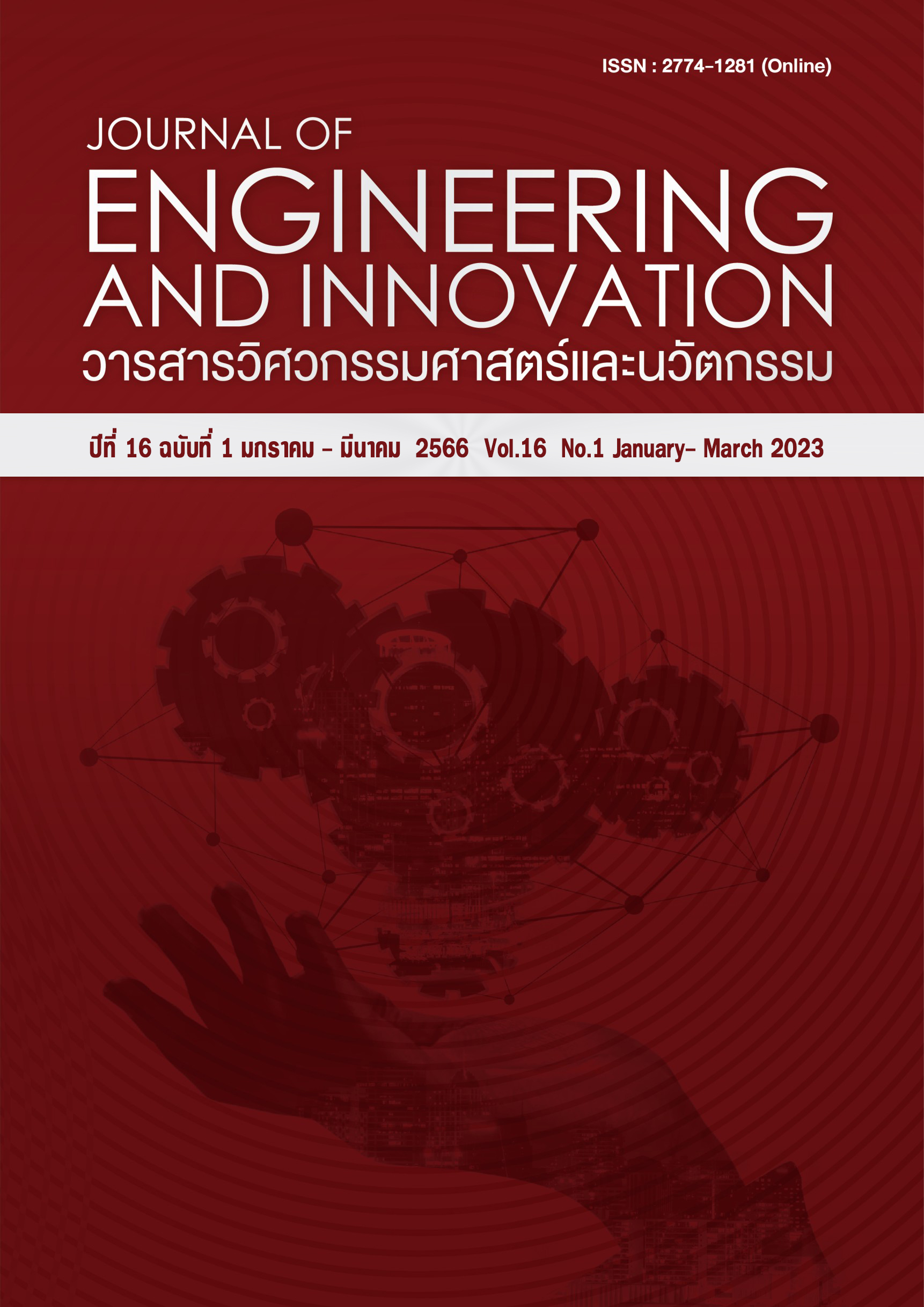Numerical simulation of small water turbine generator using k-epsilon and k-omega model
Main Article Content
Abstract
This Water turbine is the fluid machinery that changes kinetic energy of water into mechanical energy for electricity generation. The objectives of this research are to study flow of water inside water turbine wheel using computational fluid dynamics employing Finite Volume Method. Finite Volume Method was used to calculate velocities in the water turbine base on k-epsilon and k-omega model. Number of Element is an important variable affecting calculation accuracy. Then, the accuracy of element was studied and comparison was made with results from experiment and free spinning simulation. The calculation result of CFD show that the elements efficiency of 80 % results in the maximum rotation speeds of a 212-213 RPM at 7 m/s, calculated by k-epsilon and k-omega model, which shows percent error of 0.46% as compared to the actual testing.
Article Details
References
[2]. Vishal, C. and Jaymin, D. Evaluation of Hydro Turbine Forebay Using CFD, The 11th Asian International Conference on Fluid Machinery; 2011 November 21-23. IIT Madras, Chennai, India; 2011. P.1-10.
[3]. Suppachai, T. and Sataporn, W. Solid Works and Cosmos Work, Bangkok: SST; 2007. P. 1-26.
[4]. Durgin, W. W. and Fay, W. K. Some Fluid Flow Characteristic of cross-flow type turbine, The Winter Annual Meeting of ASME, New Orleans, 1984; P.77-83.
[5]. Werayoot, L. Design and Analysis of Two-Wheel Horizontal Axis Micro Water Turbine Generator Using Computational Fluid Dynamics Technique, Engineering Journal Chiangmai University, 2016; 23(1): 20-29.
[6]. Werayoot, L. (2015). Performance Testing of Vertical Axis Micro Water Turbine Generator for Driven of Available Storage Water on Building, Engineering Journal Chiangmai University, 2015; 21(1): 9-17.
[7]. วีระยุทธ หล้าอมรชัยกุล. การออกแบบอย่างเหมาะสมของกังหันน้ำผลิตไฟฟ้าขนาดเล็กที่มีเฮดต่ำด้วยวธีการวิเคราะห์ทางพลศาสตร์ของไหลโดยโปรแกรมคอมพิวเตอร์ [วิทยานิพนธ์ปริญญาวิศวกรรมศาสตรมหาบัณฑิต]. ปทุมธานี: มหาวิทยาลัยเทคโนโลยีราชมงคลธัญบุรี; 2552.
[8]. Werayoot, L. Efficiency Evaluation and Test system of the Horizotal and Vertical Axis Micro Water Turbine Generator in a Community, The 2nd MJU-Phrae National Research Conf; 2011 September 1-2. Phrae, Thailand; 2011. P. 80-87.
[9]. Nuthawut, J. and Chirakarn, S. (2012) Performance Testing of Vertical Axis Water Turbine with Friction Reduction: Blade Performance Comparison, The 9th National Kasetsart University Kamphaeng Saen Conf; 2012 December 6-7. Kasetsart University Kamphaeng Saen, Thailand; 2012. P.121-128.
[10]. Bilal Abdullah, N. (2004). Design of High Efficiency Cross- Flow Turbine for Hydro-Power Plant, International Journal of Engineering and Advance, 2013;2(3): 308-311.
[11] วีระยุทธ หล้าอมรชัยกุล. (2561). แบบจำลองความปั่นป่วน K-epsilon ( ) และ K-omega ( )สำหรับการวิเคราะห์รอบการหมุนของกังหันน้ำผลิตไฟฟ้าแบบแกนนอนสำหรับชุมชน. วารสารวิชาการ วิศวกรรมศาสตร์, 11(1), 95-104.
[12] สว่าง ชาติทอง และวิระชัย โรยนรินทร์. การออกแบบระบบทางกลสำหรับกังหันลมผลิตไฟฟ้าขนาด 20 กิโลวัตต์. งานประชุมวิชาการเครือข่ายพลังงานแห่งประเทศไทย ครั้งที่ 6. มหาวิทยาลัยศรีนรินทร์ทรวิโรฒ: เพชรบุรี; 2553. หน้า 128-132.
[13] Autodesk. 2018. CFD Support and learning. เข้าถึงได้จาก: https://knowledge.autodesk.com/
support/cfd/learnexplore/caas/CloudHelp/cloudhelp/2019/ENU/SimCFD-UsersGuide/files/GUID-423C0084-6DEA-4164-951A-96446997747C-htm.html.

